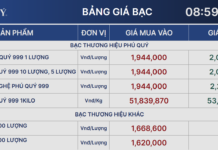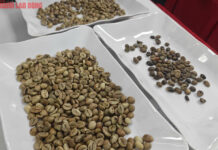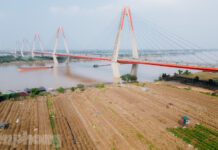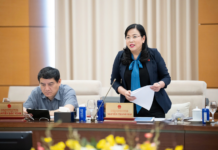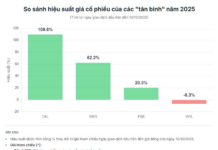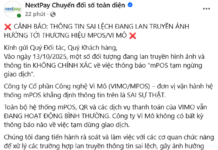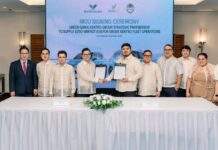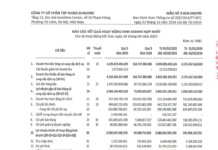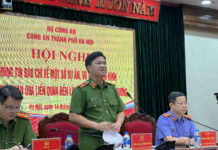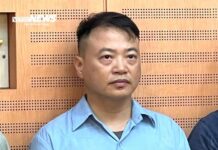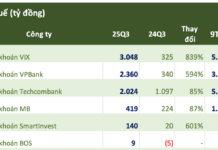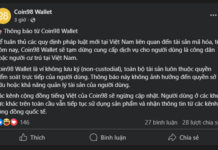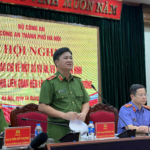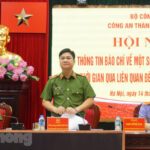Over VND 1 million per hectare per year
Mr. Tao Van Kham, Secretary of the Party Branch and Head of Na Tam 1 Village (Na Tam Commune, Sin Ho District), took us on a tour of the rubber garden in his village. He shared that following the provincial government’s directive, many households in the village enthusiastically participated in the rubber development project by contributing their land. Out of the 76 households in the village, 40 of them contributed a total of over 90 hectares of land. In addition, the collective land of 66 hectares belonging to the Na Tam 1 Village community was also included in the project. The profit-sharing scheme entitled each participating household or individual to 10% of the value of the rubber produced from their respective contributed land.

Mr. Lo Van Khen, Secretary of the Party Branch and Head of Vang Rau Village, Muong So Commune, Phong Tho District, inspects the rubber garden.
“My family contributed over 6 hectares of land, and by 2020, we started receiving payments. In 2023, my family received more than VND 10 million (over VND 1.6 million per hectare per year). I propose that the Lai Chau Rubber Joint-Stock Company increases the percentage of profit-sharing based on land contribution. If there is no increase in the value of land contribution, we will reclaim our land after the contract ends,” Mr. Kham stated.
The people of Na Tam 1 Village also shared that since contributing their land, they have not received any contracts from the company. The profit-sharing scheme provided to the contributing households in the village only includes basic information such as names, year of land contribution, area, and payment amount. Meanwhile, the amount of rubber harvested per hectare is not disclosed for comparison. According to Mr. Kham, with the current payment rate, it is challenging to sustain the livelihood of his family, which consists of nine members. In contrast, on the remaining 5,000 square meters of land, his family cultivates over 200 jackfruit trees, generating an annual income of VND 30-40 million.
Low income compared to other crops
Mr. Lo Van Sau, Chairman of Na Tam Commune People’s Committee (Sin Ho District), shared that the commune has 1,160 hectares of land contributed by the people to the Lai Chau Rubber Joint-Stock Company. “Compared to other crops, rubber has not brought the expected effectiveness. With the 10% profit-sharing from land contribution, each hectare of rubber brings in only about VND 2 million per year, which is less than short-term crops,” said Mr. Sau. Previously, many locals worked for the rubber company, but the work was arduous, leading to many people quitting their jobs.
Some communes in Phong Tho District are in a similar situation. Mr. Lo Van Khen, Secretary of the Party Branch and Head of Vang Rau Village, shared that his family contributed 1.6 hectares of land for rubber cultivation. In 2023, his family received only about VND 2 million in profit. In contrast, the 5,000 square meters of rice they cultivate yields about 100 bags (35 kg/bag) per harvest, equivalent to approximately VND 32 million. With two rice crops per year, the family earns over VND 60 million. After deducting expenses (80%), their net income is still about VND 12 million/5,000 m2/year (approximately VND 24 million/ha/year), which is higher than the income from contributing land for rubber cultivation.
In a conversation with the reporter, Mr. Lo Van Thuong, Deputy General Director of Lai Chau Rubber Joint-Stock Company, revealed that since 2007, over 5,400 households in Lai Chau Province have contributed more than 8,600 hectares of land to the company. However, more than 1,700 hectares of this land is located in ravines and steep slopes, making it unsuitable for rubber cultivation. According to Mr. Thuong, in 2023, the average yield of rubber per hectare was slightly over 1 ton. The low yield is attributed to the fact that not all areas can accommodate 500 trees per hectare as initially planned, and some trees have died during the growth process, despite replanting efforts. “We report the yield to the People’s Committee of Lai Chau Province annually, and our farms report the yield monthly. Based on these reports, we calculate the profit-sharing amount for the land contributors. After deducting operational and transportation costs, we divide the remaining profit equally among the total contributed area. Due to the low yield and market price of rubber, which is currently around VND 33 million per ton, the profit-sharing amount for land contributors is also relatively low,” explained Mr. Thuong.
Regarding the contracts signed with the people, Mr. Thuong shared that the company is in the process of finalizing the land contribution procedures and returning the contracts to the households. He emphasized that the profit-sharing scheme, which entitles households and individuals who contribute land to 10% of the value of rubber produced, was initially agreed upon between the Vietnam Rubber Industry Group and the provincial government and cannot be modified. After the rubber trees complete their life cycle, if an agreement cannot be reached with the people, the company will return the land to them.
Lai Chau Province has over 13,000 hectares of large-scale rubber plantations (the largest in the three provinces of the Northwest region) managed and exploited by three rubber companies under the Vietnam Rubber Industry Group.

